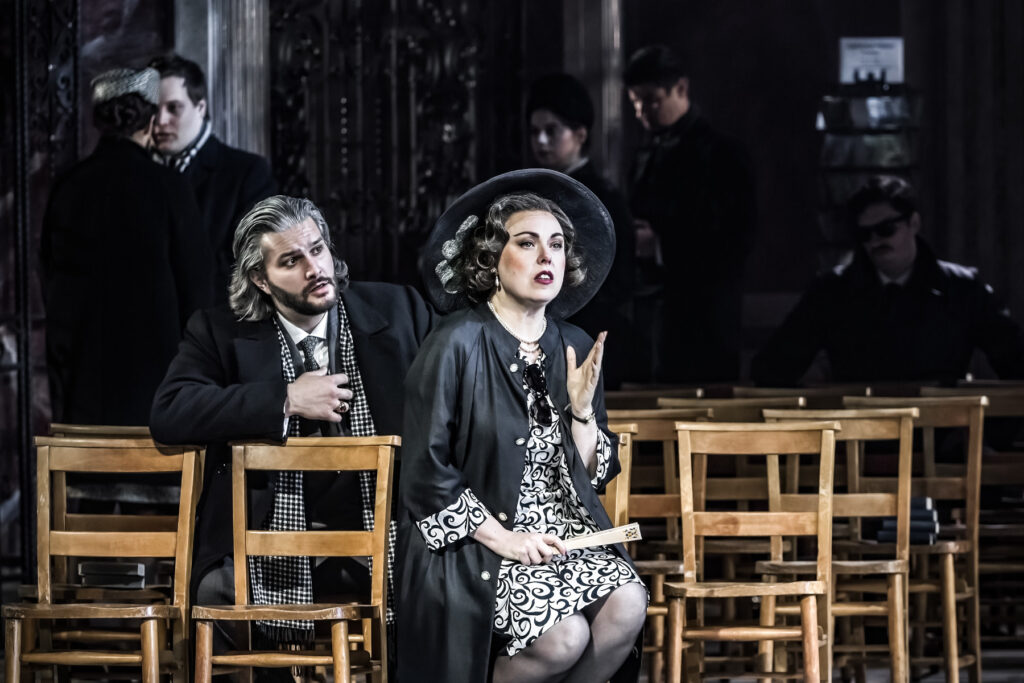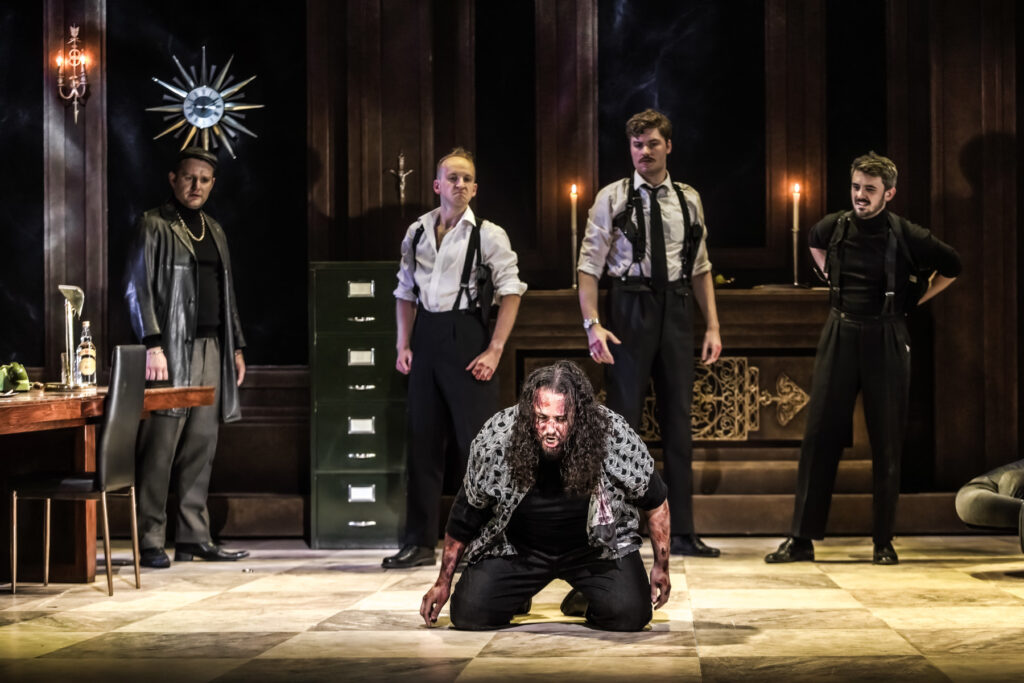Alongside a production of Monteverdi’s The Coronation of Poppea, the Grange Festival present another opera set in Rome against the backdrop of the tyrannical exercise of power, albeit nearly two millennia later. While the Royal Opera House, English National Opera, and Glyndebourne all decline to offer a new production of any of Puccini’s works in the centenary year of his death (other than a one-off performance of Suor Angelica to come from ENO in September) other houses and festivals are keen to oblige, not least with this excellent Tosca from Christopher Luscombe.
It is compellingly realistic in setting, opening with a view towards the back of a church nave which could credibly be that of Sant’Andrea della Valle as Puccini intended, with its side chapels, in one of which the artist Cavaradossi is working on a picture of St Mary Magdalene. Act Three shows an ancient fortress, from a vaulted chamber below to a parapet above, that could be the Castel Sant’Angelo, though it is not identified as such. In any case, the production is not so slavishly tied to the original, in that costumes show that we are dealing with troubles in more recent time – the programme note discusses the period of political violence and upheaval in Italy from the 1960s to ‘80s known as the Anni di piombo (the Years of Lead). Angelotti hurries about the church in the overalls of an anarchist or Communist collaborator or agent, and Scarpia is evidently a corrupt, overbearing policeman or mafia boss, as one might find in The Godfather, representing the political far-right.

Luscombe astutely draws the unedifying connection between Church and State (or at least the socially conservative ideology of whatever substate or puppet regime Scarpia and his leather-clad thugs may represent) by first immersing us in Act One’s ecclesiastical rites for the Te Deum, seeing that the set on stage implies that the altar is located back in the auditorium in our midst, and the procession of clergy and choir acknowledge that accordingly. The set shifts around for Scarpia’s study in Act Two with that missing altar now brought on and placed in a niche at the back as an essential ideological component – however perverted from its original context – of his power. His torture chamber is below a trapdoor in front of his desk, and surely not accidentally the resemblance between the long-haired and bearded Andrés Presno (as Cavaradossi) and the iconic depiction of Jesus Christ is exploited when the artist is brought up, bruised and blooded, and hurled to the floor in front of that altar.
In a sense he becomes a modern-life counterpart to the suffering Christ, Scarpia’s thugs the equivalent of Pontius Pilate’s henchmen in Roman occupied Palestine. But the production also thereby manifests a tellingly hideous parallel with the deeply Catholic ritual of benediction that had just been celebrated at the end of Act One during the Te Deum, where the body of Christ is displayed to the faithful in the transubstantiated form of the Eucharistic wafer in a monstrance. And there is a further perversion of the Eucharistic elements of bread and wine, as body and blood, with Scarpia’s vile intention of abusing Tosca’s body, having greedily enjoyed the wine of God’s creation, before he is bloodily stabbed to death. After such a heady mixture of ideology and action, the execution and suicide of Act Three come as a fairly straightforward catharsis.

Francesca Tiburzi is impressively mercurial in the title role, playfully confrontational with Cavaradossi in Act One, and defiant in her scene with Scarpia, trembling with a controlled, expressive vibrato for ‘Vissi d’arte’ in fear of the tyrant but also sorrow for the past that she recalls. Presno is just as commanding as Cavarodossi with forceful tone and ringing high notes that are not at all forced or strained – if there’s one drawback it’s simply that he might start ‘E lucevan le stelle’ with a softer desperation so as to draw an even greater contrast with its urgent climax. Andrew Manea’s hirsute, besuited Scarpia looks as suave as he sings, embodying a sly, compelling vision of evil rather than a caricature, and Vladimir-Mihai Sima makes a characterful appearance as his sidekick Spoletta.
In the small auditorium of the Grange, the Bournemouth Symphony Orchestra makes a terrific impact, but Francesco Cilluffo carefully attends to every nuance in its powerful immediacy, whether in the surging brass of the opening, the lustrous strings at the opening of Act Three, or the dark, Wagnerian shadings of the woodwind and lower brass elsewhere. Melodramatic as the opera’s scenario may be, this reading of the score conveys symphonic variety and Italianate lyricism. Together with a trenchant production, it makes worthwhile mounting afresh this most ubiquitous work.
Curtis Rogers
Tosca
Composer: Giacomo Puccini
Libretto: Giuseppe Giacosa and Luigi Illica based on the play La Tosca by Victorien Sardou
Cast and production staff:
Tosca – Francesca Tiburzi; Cavaradossi – Andrés Presno; Scarpia – Andrew Manea; Angelotti – Dan D’Souza; Sacristan – Darren Jeffery; Spoletta – Vladimir-Mihai Sima; Sciarrone – Stuart Orme; Gaoler – Meilir Jones; Shepherd boy – Sion Llywelyn-Davies; Judge – David Menezes; Roberti – Warren Gillespie; Cardinal – Richard Stead
Director – Christopher Luscombe; Designer – Simon Higlett; Lighting – Mark Jonathan; Fight Director – Maisie Carter; Conductor – Francesco Cilluffo, Bournemouth Symphony Orchestra; The Grange Festival Chorus & Children’s Chorus
The Grange, Northington, Alresford, Hampshire, 15 June 2024
Top Image: Francesca Tiburzi (Tosca) and Andrew Manea (Scarpia)
All photos © Craig Fuller